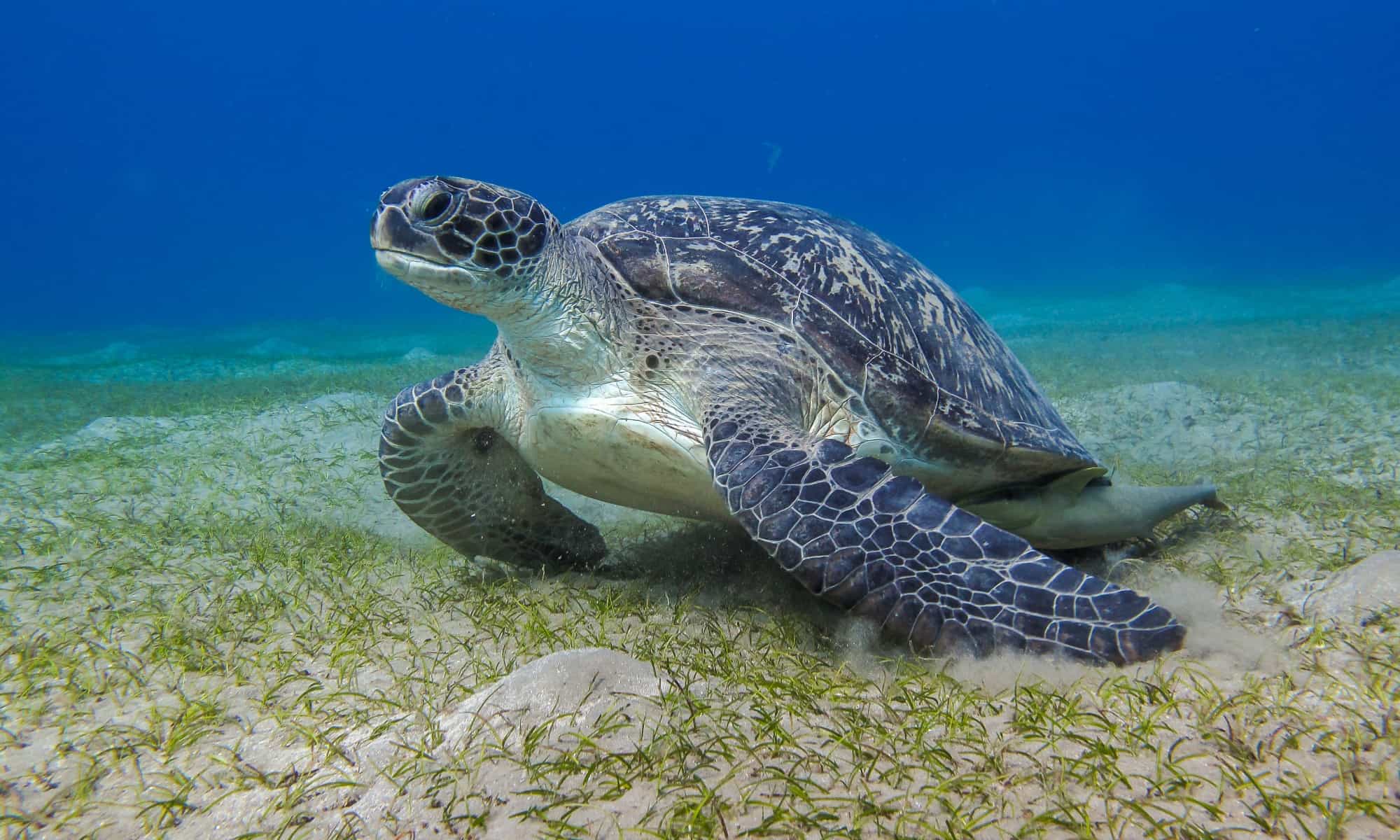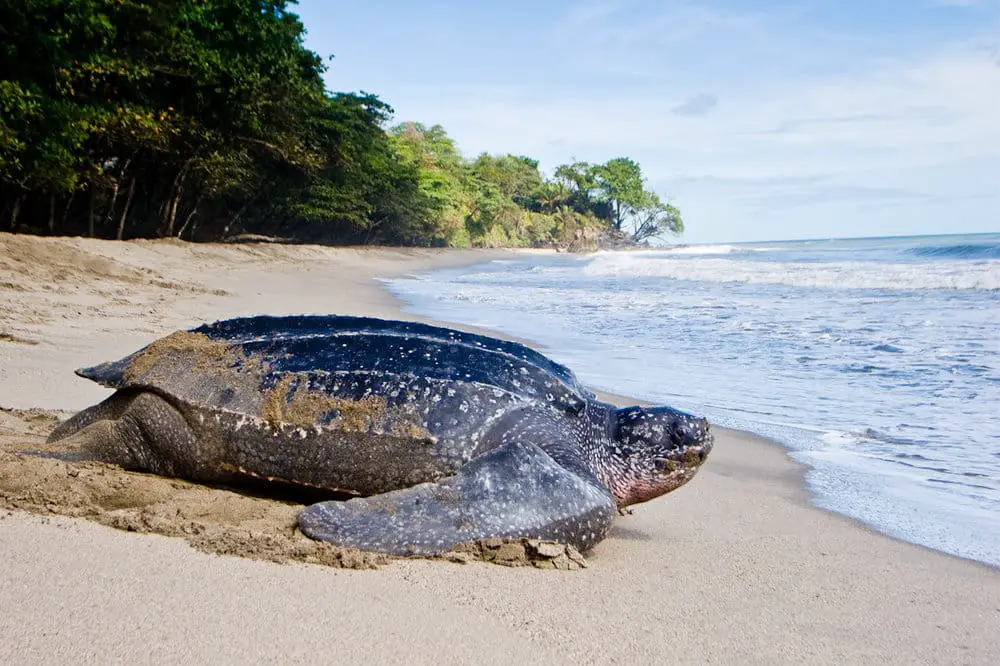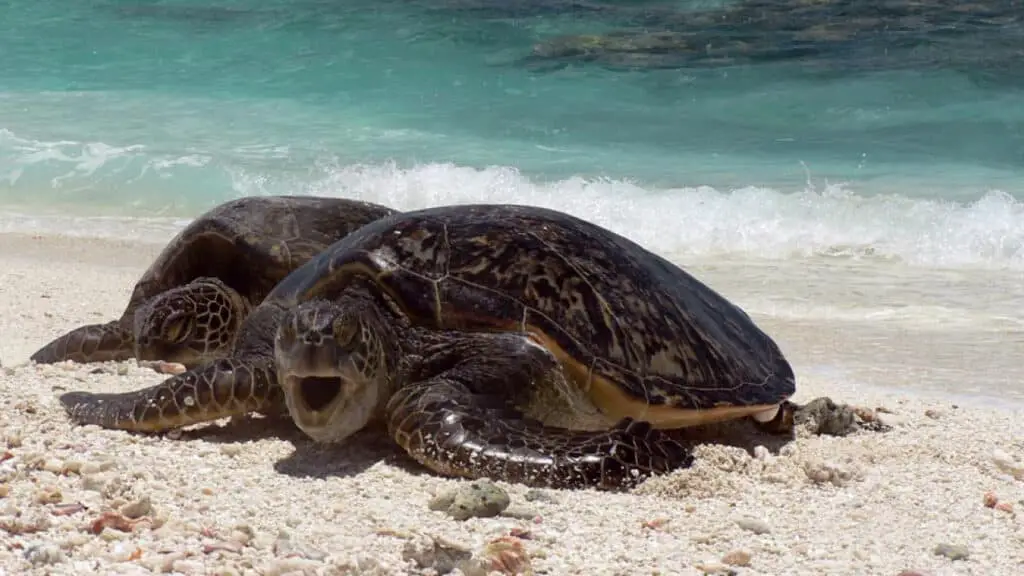How Heavy Is A Sea Turtle

Introduction
How Heavy Is A Sea Turtle: Sea turtles, these ancient and majestic creatures of the ocean, have long captivated the imagination of humans with their remarkable journeys across vast expanses of water. While we often associate them with their impressive size and graceful movements.
This inquiry delves into the fascinating world of sea turtles, shedding light on their incredible diversity and the varying weights among different species. Sea turtles come in various sizes and can be found in oceans all around the globe, from the tiny Kemp’s ridley turtle to the massive leatherback turtle. Understanding their weight not only allows us to appreciate their remarkable adaptability but also underscores the importance of conservation efforts to protect these endangered marine aquariums.
We will delve into the factors that influence a sea turtle’s weight, such as their species, age, and diet. We will also consider the ecological significance of their size and how it impacts their role in marine ecosystems. So, join us on a journey through the world of sea turtles as we uncover the secrets of their weight and gain a deeper appreciation for these gentle giants of the sea.

How much do sea turtles weigh?
The olive and Kemp’s ridley sea turtles are the smallest species, growing only to about 70 cm (just over 2 feet) in shell length and weighing up to 45 kg (100 lbs). Leatherbacks are the largest sea turtles. On average leatherbacks measure 1.5 – 2m (4-6 ft) long and weigh 300 – 500 kg (660 to 1,100 lbs).
Sea turtles, magnificent denizens of the ocean, exhibit a remarkable range of sizes and weights across their diverse species. The weight of a sea turtle largely depends on its type. The smallest, the Kemp’s Ridley, typically weighs between 75 to 100 pounds (34 to 45 kilograms) on average, while the Olive Ridley weighs slightly more, ranging from 75 to 110 pounds (34 to 50 kilograms). Moving up the scale, the Loggerhead, known for its powerful build, can weigh anywhere from 200 to 350 pounds (91 to 159 kilograms). The Green Turtle, with its streamlined physique, tends to tip the scales between 200 to 450 pounds (91 to 204 kilograms).
However, the true heavyweight champion of the sea turtle world is the leatherback. Distinguished by its unique leathery shell, it is also the largest species of sea turtle, with some individuals surpassing a staggering 2,000 pounds (907 kilograms) in weight. Their immense size is a testament to their longevity and adaptability in the world’s oceans. Despite these wide-ranging weights, all sea turtles play vital roles in maintaining the delicate balance of marine ecosystems, making their conservation a matter of utmost importance.
How heavy is the heaviest sea turtle?
Size: 4 to 6 feet (130 – 183 cm). The largest leatherback ever recorded was almost 10 feet (305 cm) from the tip of its beak to the tip of its tail and weighed in at 2,019 pounds (916 kg). Weight: 660 to 1,100 pounds (300 – 500 kg).
The title of the heaviest sea turtle belongs to the awe-inspiring leatherback. These colossal creatures can reach astounding weights, with the largest recorded individuals tipping the scales at over 2,000 pounds (907 kilograms). This astonishing mass is a testament to their remarkable adaptability and resilience in the expansive realms of the world’s oceans.
The leatherback’s distinguishing feature is its leathery shell, a departure from the hard, bony plates seen in other sea turtle species. This adaptation allows them to withstand the immense pressure of deep-sea dives, where they hunt for their preferred prey: jellyfish.
The weight of a leatherback places them in a category all their own among sea turtles. Their substantial size underscores their pivotal role in marine ecosystems, as they help regulate jellyfish populations, preventing them from overwhelming the delicate balance of the underwater world.
Despite their impressive bulk, leatherbacks face numerous threats, including habitat loss, pollution, and entanglement in fishing gear. Conservation efforts are crucial to preserving these gentle giants and ensuring their continued existence in our oceans.
How big is a 100 year old sea turtle?
It was approximately 100 years old when it died. The turtle attracted worldwide attention as it was the largest and heaviest turtle ever recorded, measuring almost 3m (9ft) in length and weighing 914 kilos (2,016 pounds).
A 100-year-old sea turtle is a living testament to the incredible longevity of these remarkable creatures. At this age, a sea turtle has undergone a century of life in the oceans, adapting and thriving in the ever-changing marine environment. In terms of size, it largely depends on the species.
The majestic leatherback, known for its impressive size, could potentially reach lengths of up to 6 to 7 feet (1.8 to 2.1 meters) and weigh over 2,000 pounds (907 kilograms). The loggerhead, another long-lived species, might measure around 3 to 4 feet (0.9 to 1.2 meters) and weigh between 200 to 350 pounds (91 to 159 kilograms) at this age.
However, it’s important to note that size can be influenced by a variety of factors including habitat, diet, and genetics. Some sea turtles might not reach these maximum dimensions. Regardless of size, a centenarian sea turtle holds immense ecological significance. Their longevity means they have witnessed and contributed to the intricate balance of marine ecosystems for generations. Preserving their habitats and ensuring their protection is crucial for maintaining the health of our oceans and the delicate web of life within them.
How big is a full size sea turtle?
The leatherback sea turtle is the largest sea turtle, measuring 2–3 m (6–9 ft) in length, 1–1.5 m (3–5 ft) in width, and weighing up to 700 kg (1500 lb). Other sea turtle species are smaller, being mostly 60–120 cm (2–4 ft) long and proportionally narrower.
A full-sized sea turtle is a truly awe-inspiring sight. The size of a sea turtle varies significantly depending on the species. The leatherback, the largest among them, is a true giant of the ocean. These magnificent creatures can reach lengths of up to 6 to 7 feet (1.8 to 2.1 meters) and weigh over 2,000 pounds (907 kilograms). Their distinguishing feature is their leathery shell, a unique adaptation that sets them apart from other sea turtles.
The loggerhead, characterized by its robust build, typically measures around 3 to 4 feet (0.9 to 1.2 meters) in length and weighs between 200 to 350 pounds (91 to 159 kilograms). The green turtle, known for its streamlined appearance, can reach lengths of 3 to 4 feet (0.9 to 1.2 meters) and weigh between 200 to 450 pounds (91 to 204 kilograms).
The hawksbill and Kemp’s Ridley turtles are comparatively smaller. Hawksbills generally grow to about 2.5 to 3 feet (0.8 to 0.9 meters) in length and weigh around 100 to 150 pounds (45 to 68 kilograms). The Kemp’s Ridley, the smallest of all, typically measures around 2 to 2.5 feet (0.6 to 0.8 meters) and weighs between 75 to 100 pounds (34 to 45 kilograms).
How much do turtles weigh in kg?
Adult male and female sea turtles are equal in size. 33 to 50 kg (73 to 110 lbs.). The Kemp’s ridley has carapace lengths of 52 to 72 cm (20.5 to 28 in.) and weigh 32 to 50 kg (66 to 110 lbs.).
The weight of turtles can vary widely depending on their species and age. For instance, the Kemp’s Ridley, one of the smallest species, weighs between 34 to 45 kilograms (75 to 100 pounds) on average. The Olive Ridley, a close relative, falls in a similar range, weighing between 34 to 50 kilograms (75 to 110 pounds). Moving up the scale, the Loggerhead, known for its robust build, can weigh anywhere from 91 to 159 kilograms (200 to 350 pounds).
The Green Turtle, with its streamlined physique, tends to weigh between 91 to 204 kilograms (200 to 450 pounds). These are the more commonly encountered sea turtles, but the largest of them all is the leatherback. Distinguished by its unique leathery shell, this species can weigh a staggering 907 kilograms (2,000 pounds) or even more.
It’s important to remember that these are broad ranges, and individual turtles can fall outside of these averages. Additionally, the weight of turtles can fluctuate due to factors like diet, habitat, and age. These magnificent creatures, regardless of their size, play vital roles in maintaining the delicate balance of marine ecosystems.
Are sea turtles stronger than humans?
These reptiles not only have stronger muscles and better lungs than humans but also they have a better sense of smell, sight and hearing.
In terms of raw physical strength, sea turtles and humans operate in vastly different realms. Sea turtles, adapted for life in the water, possess incredible strength underwater, especially in terms of endurance and agility. Their streamlined bodies and powerful flippers allow them to navigate through ocean currents with remarkable efficiency. In this element, they are undeniably more adept and powerful than humans.
On land, however, the situation is reversed. Sea turtles, not designed for terrestrial locomotion, struggle and expend a great deal of energy when moving on land. In contrast, humans, with their bipedal locomotion, are significantly more agile and capable of exerting force on land.
When considering the tasks and activities relevant to each species, it’s important to remember that “strength” can be context-dependent. For instance, a sea turtle’s strength is optimized for tasks like swimming against strong ocean currents or diving to great depths, whereas a human’s strength is more attuned to activities like lifting and manipulating objects on land.
Ultimately, comparing the strength of sea turtles and humans is like comparing apples and oranges — they excel in different environments and have evolved specific adaptations to thrive in their respective habitats.
Do sea turtles breathe air?
Reptile of the Sea. Sea turtles are adapted to live in the ocean, with some unique features that help them to survive in the marine environment. As reptiles, they require air to breathe and land to lay their eggs. However, the majority of their lives are spent underwater.
Sea turtles are air-breathing reptiles. Despite their adaptation to life in the water, they are not equipped with gills like fish. Instead, sea turtles must surface to breathe. They have specialized lungs that allow them to extract oxygen from the air.
Typically, sea turtles are capable of holding their breath for extended periods, with some species capable of remaining submerged for several hours. This remarkable ability is crucial for their survival, especially during activities like foraging for food or evading predators.
When a sea turtle comes to the surface to breathe, it extends its head above the water, takes a series of quick breaths, and then submerges again. The frequency at which they need to surface varies depending on factors like species, age, and activity level. Younger turtles tend to surface more frequently than adults.
This adaptation to surface breathing means sea turtles need access to both terrestrial and marine environments. Coastal habitats, where they can find suitable nesting sites, are particularly vital for their life cycle. Ensuring the conservation of these habitats is crucial for the continued survival of these magnificent creatures.
Do sea turtle hatchlings weigh the same as adults?
Sea turtle hatchlings are considerably smaller and lighter than their adult counterparts. When they first emerge from their nests, hatchlings are tiny, typically measuring just a few inches in length and weighing a mere fraction of what an adult sea turtle does. For example, a newly hatched loggerhead sea turtle may measure around 4 centimeters (about 1.5 inches) in length and weigh only about 20 grams (less than an ounce).
In contrast, adult loggerheads can grow to lengths of 90 to 110 centimeters (about 3 to 3.6 feet) and weigh between 80 to 160 kilograms (176 to 352 pounds).
The substantial size difference between hatchlings and adults reflects the extraordinary growth and development these creatures undergo over their lifespan, which can span several decades. As sea turtles mature, they undergo significant physiological changes and accumulate body mass through years of feeding in the ocean.
The early stages of a sea turtle’s life are a critical period, fraught with challenges and dangers. Hatchlings must navigate their way to the safety of the ocean, avoiding predators and environmental hazards. Only a small fraction of hatchlings will survive to adulthood, making conservation efforts to protect nesting beaches and vital marine habitats even more crucial.

Conclusion
We’ve learned that the weight of a sea turtle can vary significantly depending on their species, age, and diet. From the petite Kemp’s ridley turtle to the colossal leatherback turtle, each species has adapted to its unique environment, which is reflected in their size and weight.
Beyond the curiosity about turtles eat, we’ve also gained a deeper understanding of the crucial role sea turtles play in marine ecosystems. Their size and behaviors, such as grazing on seagrass beds or transporting nutrients across vast oceanic distances, contribute to the balance and health of our oceans.
However, it is essential to recognize the challenges that sea turtles face today, including habitat destruction, pollution, and accidental bycatch in fishing operations. Conservation efforts are more critical than ever to protect these magnificent creatures and ensure their continued survival.
In our quest to comprehend how heavy a sea turtle is, we’ve embarked on a journey of discovery and conservation. Let this newfound knowledge inspire us to take action, raise awareness, and work together to safeguard the future of sea turtles and the oceans they call home. By doing so, we can ensure that these ancient and majestic beings continue to grace our seas for generations to come.



